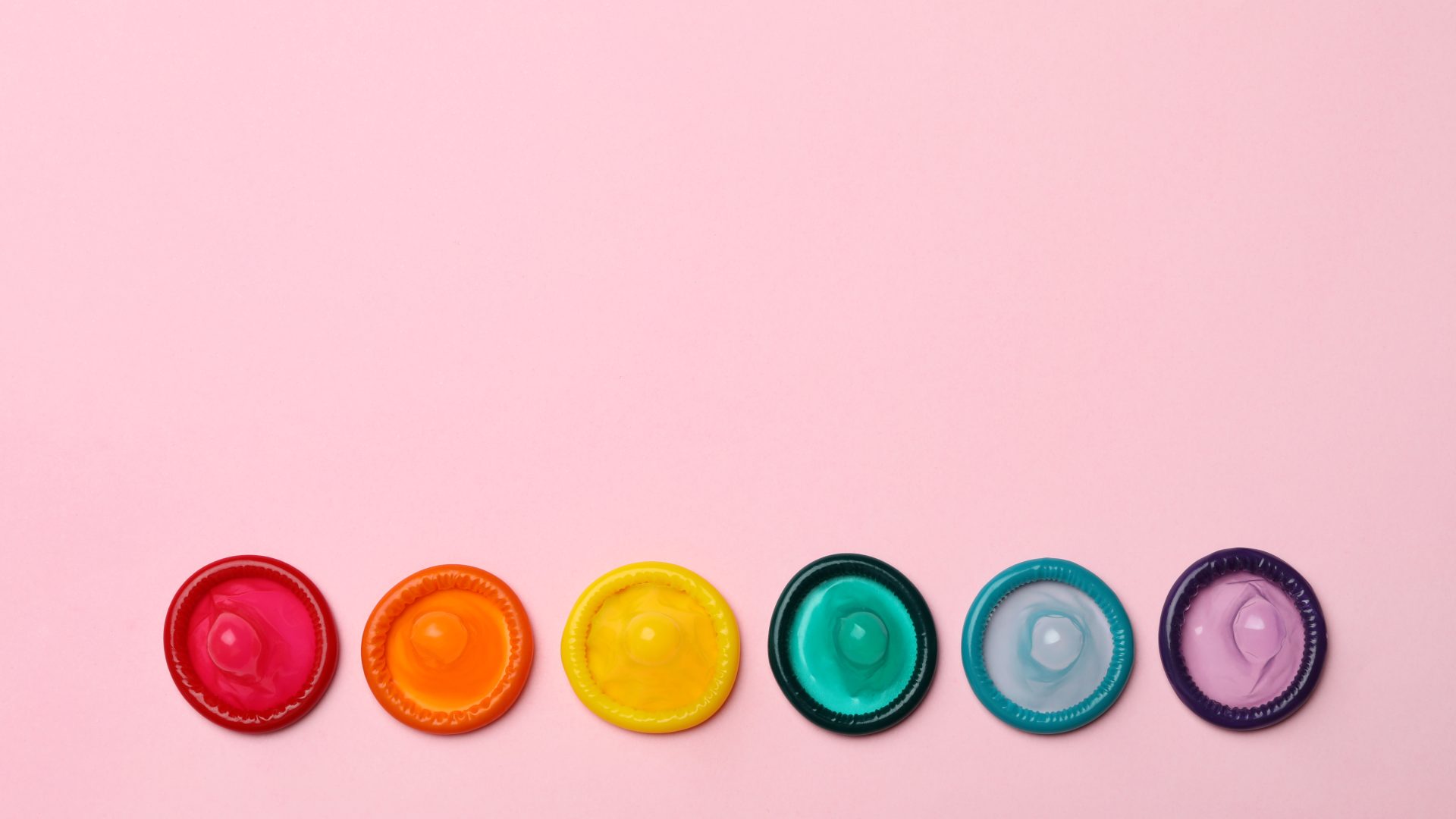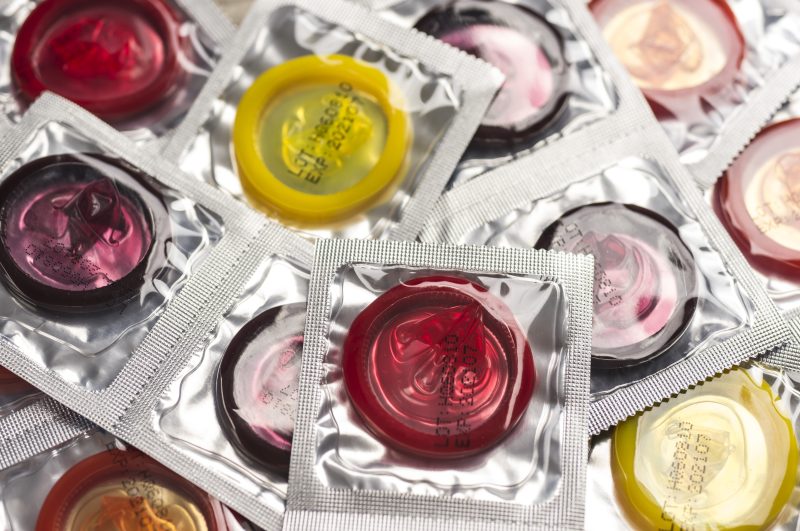Finding the right condom and knowing how to use it properly can help prevent condom failure and avoid unplanned pregnancies. Making the right condom choice can also makes sex more pleasurable for you and your partner(s) while reducing the risk of HIV and STIs.
Key things to know
Using a condom is the responsibility of all partners.
Here are the key things to remember when negotiating condom use with your partners:
- Asking about condoms will not ruin the moment.
- Start the conversation about condoms before having sex.
- Setting boundaries is a key way to feel comfortable during sexual situations.
Visit our other pages for more information on STI prevention and consent. If you have any questions or concerns regarding discussing condom use, you can also contact us for advice and support.
Get in touch
What are the different types of condoms?
External condoms are the most type of popular condoms. They are worn on the outside of the penis and semen is collected in a teat-shaped pouch at the end of the condom, preventing the sperm from transmitting to your partners.
External condoms are usually made of a very thin transparent latex and they come in different sizes and textures. There are also latex-free condoms if you have a rubber allergy.
Internal condoms are latex sleeves that are worn on the inside of the vagina. Just like the external condoms, this is a barrier contraceptive method that prevents the sperm from reaching the womb.
Dental dams are thin, square pieces of latex that are worn on the mouth during oral sex. While there is no risk of unplanned pregnancy during oral sex, dental dams help to reduce the risk of STIs, such as syphilis and gonorrhoea.
Where do I get condoms?
There are lots of places where you can get hold of free condoms and lube in Scotland. Waverley Care offers free condoms by post for people living in Highland and Argyll & Bute. Check out our free condoms by post page for more information and schemes in other locations.
Free condoms and sachets of lube are also available in some gay bars and clubs.
You can also buy condoms and lube from supermarkets, pharmacies and many other retailers. Just make sure that the condoms you choose have either the BSI Kitemark or the European CE mark, as that shows that they are of a high standard.
How do I find the right size of external condom?
Penises come in all different shapes and sizes, and so do condoms. The best way to find the right size of external condom is to try out different sizes.
If you aren’t experienced in using a condom, trying it on during foreplay or while masturbating can help you to master how to put it on and to find the one that feels most comfortable.
It is also useful to have a range of different sizes available during sex in case you need it.
How to I use internal condoms?
Internal condoms are a good alternative to external condoms, as they work in a similar way to protect you from STIs and unplanned pregnancies. Internal condoms are put inside the vagina in a similar way to tampons. The inner part of the condom should sit near the cervix while the outer ring will sit outside of the vulva. To ensure safe sex and effective contraception, it’s important to guide the penis into the condom and not into the sides of the vagina.
Condom failure and how to avoid it
Most sexually active people, at some point, will have a condom fail while they’re are having sex, either through the condom bursting or slipping off.
This can put you and your sexual partners at risk of HIV and other STIs. If your condom has failed and you think you have been at risk of HIV you should to access PEP as soon as possible.
Using condoms correctly is the best way to protect yourself from HIV and STIs. It’s very much a case of practice makes perfect, and getting to know which size and type fit you.
Here are our top tips to get the most out of your condom:
- Find the right fit for you.
- If you use an external condom, make sure it is put on an erect (hard) penis. Roll it all the way down the penis and pinch the empty space near the tip of the penis to avoid air bubbles.
- If you use internal condoms, make sure there are no tears before putting it in.
- Never use both internal and external condoms at the same time as it might cause tearing.
- You can never use too much lube.
- Change your condom every 30 minutes in longer sessions.
- Never re-use condoms!
Condom issues
Beyond the issues around condom failure, there are other common issues when it comes to condom use.
If you feel that using a condom leads to a loss of intimacy with your partners, try to talk to them about it and look at ways to make condoms a part of your sex life. For example, engaging in foreplay and trying different ways to put on a condom may help. It’s worth remembering that condoms are there to protect you and your partners from STIs, including HIV.
Some people say that using condoms reduces the sensation of sex. If this is you, you may want to try different types of condoms to see what works for you. Thinner condoms are not any less safe than thicker varieties and some condoms have different textures that can increase your pleasure. The more aroused you are during sex, the more sensation you will feel, so make sure you spend time getting turned on or turning your partners on.
Some people feel that condoms are the cause of erection loss. In many cases this can be resolved by using the right condom, learning the best way to get it on and spending time enjoying foreplay. The use of erectile dysfunction medication is not recommended to overcome this problem unless it has been suggested by the doctor.
Sex without condoms
Condoms, when used properly, are the most effective way to prevent the transmission of HIV and other STIs. If you have sex without a condom, it is important to know your risk of HIV and other STIs and the ways you can reduce this risk, like taking PrEP.
Withdrawing is a method of contraception where the penis is pulled out of the vagina before ejaculation to prevent semen from entering the vagina. Even though the risk of HIV using this method is slightly reduced, there is still a high risk of HIV being transmitted via pre-seminal fluid (pre-cum). There is also high risk of STIs being transmitted if you use this method and it is not guaranteed to work in preventing unplanned pregnancies.
A common route of transmission of HIV and other STIs is through unprotected sex within relationships. People often make a decision to stop using condoms because they are in a steady relationship and they believe that they don’t have any STIs.
However, if you or your partner(s) have had other partners, it’s a good idea to get a sexual health check-up and make sure neither one of you have any STIs.
Even if you’ve tested negative for STIs and HIV, the decision to stop using condoms is based on trust. For example that neither you, nor your partner(s), will have sex outside the relationship, or that if one does, they will use condoms. However, we’re all capable of doing things we might later regret and many people who have felt totally committed within a relationship have found themselves having high-risk sex outside of it.
If you’re in a relationship and thinking about stopping condom use, you should talk things through to make sure you’re on the same page.
If you decide to stop using condoms and are worried about your HIV risk, you can check out our page on PrEP – a pill that can protect you from HIV.
When a partner removes the condom without your explicit consent this is called stealthing. When this happens, it means you are having unprotected sex.
If you have agreed to use a condom, but it is removed during sex without your agreement, then the consent is over and it is not consensual. Stealthing is illegal and a crime. It doesn’t matter if you continue to have sex and climax.
If this has happened you should speak to your local sexual health service, who may be able to offer you PEP to protect you from HIV, if they think you’ve been at risk. They can also support you in reporting this to the police.
Negotiating condom use during sex
Often, if your sexual partner(s) don’t want to use protection they may try to talk you out of using it, but it’s always up to you. If you want to use protection but your partner(s) refuse, you have the right to say no.
Even if you trust your partner(s), there’s no guarantee that they haven’t been exposed to an STI, particularly if they have had condomless sex in the past. You don’t have to take their word for it and you don’t have to have unprotected sex unless you want to.
If you are worried about your HIV risk, PrEP is effective in preventing the transmission of HIV. However it will not protect you from other STIs, so it is still important to use condoms.
Looking for advice?
If you are looking for information and advice on the transmission, prevention and treatment of HIV and sexually transmitted infections, we are here to help. Get in touch by filling out our contact form.




